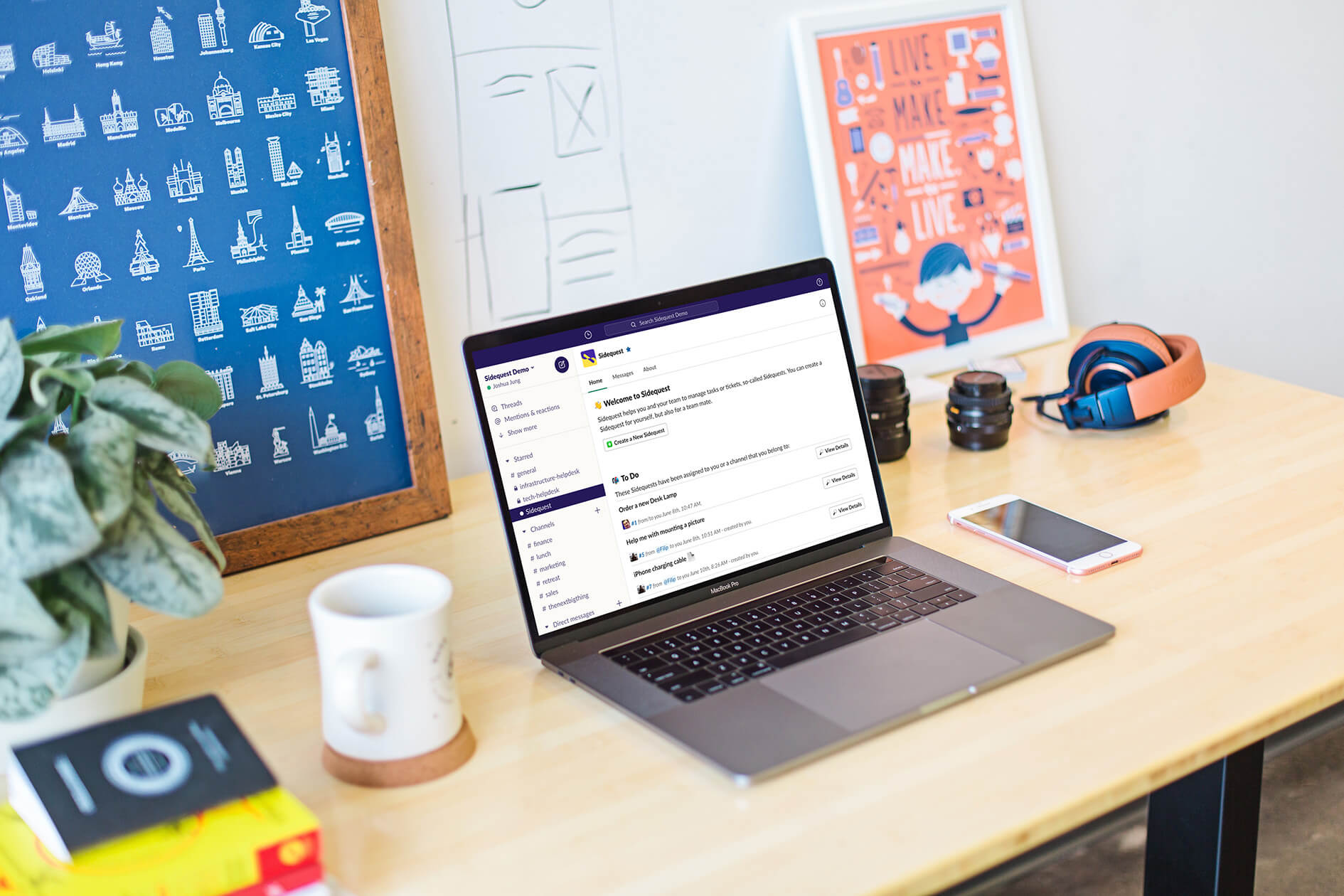Introduction
Slack has become a household name in the business world, revolutionizing the way teams communicate and collaborate. This innovative platform offers a streamlined messaging system that enables real-time conversations, file sharing, and integration with other productivity tools. With its intuitive interface and extensive features, Slack has swiftly gained popularity and is now used by millions of professionals worldwide.
What exactly does Slack mean? Simply put, Slack refers to both the company itself and the collaborative platform it provides. The name “Slack” originates from the acronym “Searchable Log of All Conversation and Knowledge,” highlighting the platform’s core mission of keeping all team communication and information easily searchable and accessible.
Since its launch in 2013, Slack has grown exponentially, catering to businesses of all sizes and industries. As a cloud-based communication tool, it has transformed how teams collaborate, bringing together both remote and in-house employees in a virtual workspace. With its remarkable success and global recognition, it is clear that Slack is not just another messaging app; it is a game-changer in the realm of workplace productivity.
In this article, we will delve deeper into the world of Slack, exploring its history, features, benefits, and how to effectively use it. Whether you are a small business owner, a team leader, or an employee looking to optimize workplace communication, this comprehensive guide will provide you with the knowledge and insights necessary to leverage the power of Slack to its fullest potential.
Definition of Slack
Slack can be defined as a cloud-based collaboration platform that enables efficient and seamless communication among team members. It serves as a centralized hub for team conversations, file sharing, and project management. Unlike traditional email communication, Slack promotes real-time communication, encouraging instant feedback and faster decision-making.
At its core, Slack is a messaging app that allows users to create channels for various team discussions. Channels can be organized by topics, projects, or departments, ensuring that conversations remain organized and easily accessible. Within these channels, team members can exchange messages, share files, and collaborate on tasks.
One of the key features that sets Slack apart is its search functionality. Every message, file, and link shared within Slack is indexed and searchable, creating a database of knowledge that can easily be accessed at a later time. This ensures that important information doesn’t get lost in lengthy email chains or scattered across different platforms.
Slack also supports direct messaging, allowing team members to have private conversations and share sensitive information securely. This feature is particularly useful for one-on-one communication or for discussing confidential matters that should not be shared with the entire team.
Besides text-based messaging, Slack offers a range of communication options to cater to different needs. Users can make audio or video calls, host virtual meetings, and even share their screens for better collaboration. This flexibility makes Slack suitable for both casual conversations and formal discussions.
Furthermore, Slack integrates with a variety of third-party apps and services, allowing users to bring all their necessary tools and workflows into one platform. From project management tools to customer support platforms, Slack can seamlessly connect with these applications, streamlining workflows and enhancing productivity.
In summary, Slack is a communication and collaboration platform designed to streamline team communication and enhance productivity. With its versatile features and intuitive interface, Slack helps teams work more efficiently and effectively, facilitating seamless collaboration and knowledge sharing.
The History of Slack
The story of Slack dates back to 2009 when a company called Tiny Speck began working on a massively multiplayer online game called Glitch. As the development team grew, they faced challenges with communication and collaboration, which led to the creation of a real-time messaging system called IRC (Internet Relay Chat). However, they realized that IRC alone was not sufficient to meet their needs.
In 2013, Tiny Speck decided to pivot and focus on developing a team communication platform instead of pursuing the game. This marked the birth of Slack. The team, led by Stewart Butterfield, set out to create a solution that would streamline communication and bring all team discussions and information into one centralized platform.
Slack was officially launched in August 2013 as an internal tool for Tiny Speck. It quickly gained traction and became the primary means of communication for the team. Recognizing the potential of Slack as a standalone product, Tiny Speck decided to spin off the communication platform into its own company, which was renamed Slack Technologies, Inc.
The platform’s popularity began to soar when it was opened up to the public in February 2014. Teams across various industries started adopting Slack as their go-to communication tool, impressed by its user-friendly interface, robust features, and ability to integrate with other tools seamlessly.
Slack’s growth and success continued in the following years. In 2015, the company raised a significant amount of funding, valuing Slack at over $1 billion. The platform’s user base expanded rapidly, reaching millions of active users within a short period.
As Slack gained more recognition, it became evident that it was not just a messaging platform; it was transforming the way teams worked. Organizations of all sizes, from startups to multinational corporations, embraced Slack to enhance collaboration, promote transparency, and improve overall productivity.
Slack has consistently introduced new features and improvements based on user feedback. The platform has expanded beyond messaging to offer file sharing, integration capabilities, advanced search functionalities, and robust security measures. This continuous evolution has solidified Slack’s position as a leading communication and collaboration tool in the business world.
Today, Slack is one of the most widely used and respected communication platforms, connecting teams across the globe. Its success story is a testament to the power of innovation, adaptability, and the ever-growing need for efficient team communication and collaboration.
Features of Slack
Slack offers a wide range of features that make it an indispensable tool for team communication and collaboration. Whether you’re working on a small project or coordinating with a large team, Slack provides a robust set of features to streamline your workflow and enhance productivity. Let’s explore some of the key features of Slack:
1. Channels: Slack allows you to create channels for different topics, projects, or departments. This helps keep conversations organized and ensures that relevant information is easily accessible.
2. Real-Time Messaging: With Slack, you can send messages and receive instant feedback in real-time. This promotes faster decision-making, reduces delays, and fosters efficient collaboration.
3. Search Functionality: Every message, file, and link shared in Slack is searchable. This means you can easily find and retrieve important information without digging through mountains of emails or scrolling through endless chat history.
4. File Sharing: Slack enables seamless file sharing within channels or through direct messages. You can upload documents, images, videos, and other files, making it convenient for team members to access and collaborate on shared resources.
5. Integrations: Slack integrates with a wide range of third-party apps and services. This allows you to connect your favorite tools, such as project management, customer support, and productivity apps, to streamline workflows and enhance productivity.
6. Notifications and Reminders: Slack keeps you updated with real-time notifications, ensuring that you don’t miss important messages or deadlines. You can customize your notification settings to stay informed while minimizing distractions.
7. Audio and Video Calls: Slack offers audio and video calling capabilities, allowing you to have virtual meetings and discussions with team members, regardless of their location. This feature facilitates face-to-face communication and promotes effective collaboration.
8. App Marketplace: Slack has a robust app marketplace with thousands of apps and integrations available. From project management tools to productivity apps, you can find and install the apps that best suit your team’s needs, further enhancing your Slack experience.
9. Security and Compliance: Slack is designed with security in mind. It offers features such as data encryption, multi-factor authentication, and compliance certifications to ensure the confidentiality and integrity of your team’s conversations and data.
10. Customization: Slack allows you to customize your workspace by choosing themes, setting up automated workflows, and creating custom emojis. This personalization enables you to tailor Slack to your team’s unique preferences and working style.
These are just some of the many features that make Slack a powerful communication and collaboration platform. By leveraging these features, teams can streamline their workflows, enhance productivity, and foster effective communication among team members.
Benefits of Using Slack
Slack offers numerous benefits that make it an invaluable tool for team communication and collaboration. From improved productivity to streamlined workflows, here are some of the key advantages of using Slack:
1. Efficient Communication: Slack enables real-time messaging, eliminating the need for back-and-forth email conversations. This promotes faster communication, instant feedback, and quicker decision-making.
2. Organized Conversations: With Slack’s channel-based structure, you can keep discussions organized by topics, projects, or departments. This helps team members easily find and reference relevant information, reducing time spent searching for past conversations.
3. Centralized Knowledge Base: Slack’s searchable database allows you to store and retrieve important information, files, and links. This creates a centralized knowledge base that team members can access whenever they need, fostering knowledge sharing and reducing information silos.
4. Enhanced Collaboration: Slack’s file sharing, collaborative editing, and integration capabilities enable seamless collaboration among team members. It allows for real-time document collaboration, reducing the need for multiple versions of the same file and ensuring everyone is working on the latest version.
5. Remote Team Connectivity: Slack is especially useful for remote teams, allowing them to stay connected and engaged. It bridges the geographical gap by providing a virtual workspace where remote team members can collaborate, communicate, and feel connected.
6. Increased Productivity: By eliminating the inefficiencies of email, Slack helps teams stay focused and productive. Quick and direct communication, combined with powerful search capabilities, ensures that critical information is readily available, enabling teams to make faster progress on tasks and projects.
7. Flexible Communication Options: Slack offers various communication options, including audio and video calls, screen sharing, and integrations with other meeting tools. This flexibility accommodates different communication preferences and fosters effective collaboration among team members.
8. Customizable Workflow: Slack allows you to customize your workspace and workflows to match your team’s needs and preferences. From automated notifications to custom app integrations, Slack can be tailored to enhance your team’s productivity and efficiency.
9. Increased Transparency: Slack promotes transparency within teams by providing visibility into conversations and actions. This transparency helps team members stay informed about ongoing projects, updates, and decisions, fostering a sense of trust and accountability.
10. Improved Team Engagement: Slack’s interactive and collaborative features create a more engaging environment for teams. It encourages open discussions, enables quick feedback loops, and helps build a sense of community and camaraderie among team members.
These benefits highlight the value of Slack as a tool for effective team communication and collaboration. By leveraging these advantages, teams can elevate their productivity, streamline their workflows, and foster a more connected and engaged workforce.
How to Use Slack
Getting started with Slack is easy, and mastering its features can greatly enhance your team’s communication and collaboration. Here is a step-by-step guide on how to use Slack effectively:
1. Create an Account: Visit the Slack website or download the app, and create an account. You can choose to create a new team or join an existing team if you have been invited.
2. Create Channels: Set up channels for different topics, projects, or departments. Channels keep conversations organized and ensure that relevant information is easily accessible.
3. Invite Team Members: Invite your team members to join your Slack workspace. You can send an email invitation or generate a unique invitation link for them to join.
4. Explore the Interface: Familiarize yourself with Slack’s user interface. The sidebar on the left displays your channels, direct messages, and apps. The main area in the middle is where you can view and participate in conversations.
5. Send Messages: Start conversations by sending messages in the appropriate channels. Simply type your message in the text input field at the bottom of the screen and press Enter. Use @mentions to notify specific team members or groups.
6. Share Files: To share files, click on the paperclip icon in the message input field. You can upload files from your computer or choose files from integrated cloud storage platforms like Google Drive or Dropbox.
7. Utilize Threads: Threads are useful for organizing and continuing specific conversations within a channel. Click on a message and select the “Reply in thread” option to keep related discussions together.
8. Customize Notifications: Manage your notification settings to stay informed without being overwhelmed. You can choose to receive notifications for mentions, messages in specific channels, or have notifications turned off during certain hours.
9. Use Search: Take advantage of Slack’s powerful search functionality. Use the search bar at the top to find specific messages, files, or links shared within Slack. You can filter your search by channel, person, or date to narrow down results.
10. Integrate Third-Party Apps: Explore the Slack App Directory and integrate your favorite third-party apps to enhance productivity. From project management tools to communication platforms, there are numerous integrations available that can streamline your workflows.
11. Explore Advanced Features: As you become more comfortable with Slack, delve into advanced features like audio and video calls, screen sharing, and using slash commands. These features can further enhance your team’s communication and collaboration.
12. Encourage Best Practices: Establish guidelines for how your team should use Slack. Encourage proper channel usage, clear and concise communication, and respectful interactions to promote effective collaboration.
By following these steps and familiarizing yourself with Slack’s features, you can optimize your team’s communication and collaboration, saving time and improving productivity.
Tips and Tricks for Using Slack Effectively
While Slack is designed to simplify team communication and collaboration, it’s important to utilize its features effectively to maximize productivity. Here are some tips and tricks to help you make the most of Slack:
1. Use Keyboard Shortcuts: Slack offers a range of keyboard shortcuts that can help you navigate and interact with the platform more efficiently. Familiarize yourself with these shortcuts to save time and streamline your workflow.
2. Set Status and Availability: Utilize Slack’s status feature to let your team know if you’re available, away, or working on a specific task. This helps manage expectations and reduces interruptions.
3. Pin Important Messages: Use the “Pin to channel” option to keep important messages easily accessible. Pinning messages ensures that critical information or decision-making threads are not lost in the chat history.
4. Utilize Reminders: Slack allows you to set reminders for yourself or others. Use this feature to stay on top of important deadlines or follow up on pending tasks.
5. Create Custom Emojis: Personalize your Slack workspace by creating custom emojis. You can create emojis that reflect your team’s culture or promote inside jokes, adding a touch of fun and personality to your conversations.
6. Create and Use Templates: If your team frequently works on repetitive tasks or projects, consider creating and using templates. Templates help standardize workflows and save time by providing a starting point for new projects or processes.
7. Organize and Name Channels Strategically: Ensure that your channels are named and organized in a way that makes sense for your team. Use descriptive names and consider creating sub-channels within larger channels to further organize discussions.
8. Encourage Proper Channel Etiquette: Set guidelines for how channels should be used. Encourage team members to stay on topic and avoid spamming or unnecessary notifications. Regularly review and clean up channels to remove outdated or irrelevant content.
9. Enable Do Not Disturb: Use the “Do Not Disturb” mode when you need uninterrupted focus time. This setting mutes notifications during specific hours, allowing you to work without distractions or interruptions.
10. Utilize Slackbot: Slackbot is a built-in virtual assistant that can help answer common questions or provide information. Take advantage of Slackbot to automate routine tasks or provide quick access to resources.
11. Integrate Productivity Tools: Integrate Slack with your favorite productivity tools to streamline workflows. Connect project management tools, time-tracking apps, or note-taking tools to keep all your information in one centralized place.
12. Encourage Active Participation: Foster a culture of active participation by encouraging team members to contribute and engage in discussions. Encourage regular check-ins, provide feedback, and recognize achievements to keep the momentum going.
By implementing these tips and tricks, you can harness the full potential of Slack and create a more efficient and productive team communication and collaboration environment.
The Different Plans and Pricing Options for Slack
Slack offers various plans and pricing options to cater to the needs of different teams and organizations. Whether you’re a small business, a growing startup, or an enterprise-level company, Slack provides flexible pricing plans to accommodate your requirements. Here are the different plans available:
1. Free Plan: Slack offers a free plan that provides basic features and functionality for small teams. With the free plan, you can create and join channels, search up to 10,000 most recent messages, and integrate with a limited number of third-party apps.
2. Standard Plan: The Standard plan is designed for small to medium-sized businesses. It offers additional features such as guest accounts, group voice and video calls, custom retention policies for messages and files, and increased app integrations. The Standard plan is available at a per-user pricing.
3. Plus Plan: The Plus plan is suitable for larger organizations that require advanced security, compliance, and administrative controls. In addition to the features offered in the Standard plan, the Plus plan includes features like SSO (Single Sign-On), user provisioning and deprovisioning, and 24/7 support. The Plus plan is also available at a per-user pricing.
4. Enterprise Grid: Enterprise Grid is designed to meet the needs of large-scale organizations. It provides advanced security, compliance, and administrative controls across multiple workspaces or divisions. Enterprise Grid offers enhanced features like Enterprise Key Management, SCIM provisioning, and dedicated customer support. The pricing for Enterprise Grid is customized based on the organization’s requirements.
It is worth noting that Slack regularly introduces new features and may update their pricing plans accordingly. Additionally, there may be discounts or special offers available for specific industries or organizations. It is recommended to visit the Slack website or contact their sales team for the most up-to-date pricing information and to discuss specific requirements.
By offering different plans and pricing options, Slack ensures that teams of all sizes and budgets can access and benefit from their powerful communication and collaboration platform.
Integrations with Other Apps and Services
One of the key strengths of Slack is its ability to integrate seamlessly with a wide range of third-party apps and services. These integrations enhance productivity, streamline workflows, and bring all the necessary tools and information into one centralized platform. Here are some examples of the integrations available with Slack:
1. Project Management Tools: Slack integrates with popular project management tools like Asana, Trello, and Jira. This integration allows you to receive notifications, updates, and reminders about tasks and projects directly in Slack, keeping you informed and enabling collaboration without switching between different platforms.
2. File Storage and Sharing Platforms: Integrating Slack with cloud storage services like Google Drive, Dropbox, and OneDrive allows for seamless file sharing and collaboration. You can easily share files, access documents, and collaborate on them within Slack, eliminating the need to switch between different platforms.
3. Productivity Apps: Slack integrates with various productivity apps like Google Calendar, Evernote, and Office 365. This integration enables you to receive event reminders, create to-do lists, and access important documents or notes right within Slack, boosting efficiency and keeping everything organized.
4. Customer Support Platforms: Slack integrates with customer support tools such as Zendesk, Intercom, and Help Scout. This integration allows your support team to receive and respond to customer queries or tickets directly within Slack, improving response time and collaboration between teams.
5. Communication and Collaboration Tools: Slack seamlessly integrates with tools like Zoom, Google Meet, and Microsoft Teams, enabling audio and video calls, screen sharing, and virtual meetings directly within Slack. This integration consolidates communication channels and streamlines collaboration, making it easier for teams to connect and collaborate.
6. Development and DevOps Tools: Slack integrates with development tools like GitHub, Bitbucket, and Jenkins. This integration allows developers to receive notifications, track code changes, and collaborate on projects within Slack, enabling efficient and streamlined team coordination.
7. Analytics and Reporting Tools: Slack can be integrated with analytics and reporting tools such as Google Analytics and Salesforce. This integration enables you to receive data insights and updates directly within Slack, facilitating real-time decision-making and data-driven discussions.
8. HR and People Management Tools: Slack integrates with HR and people management platforms like BambooHR and ADP. This integration allows HR teams to automate processes, share updates, and manage employee information within Slack, improving communication and streamlining HR workflows.
These are just a few examples of the countless integrations available with Slack. The wide range of integrations ensures that teams can bring all the tools and services they rely on into one central platform, enabling seamless collaboration and enhancing productivity.
Case Studies: How Companies Benefit from Using Slack
Many companies have embraced Slack as their go-to communication and collaboration tool, experiencing significant improvements in their productivity, efficiency, and team dynamics. Let’s explore a few case studies that highlight the benefits companies have gained from using Slack:
1. Slack at Airbnb: Airbnb, the global online marketplace for lodging and experiences, implemented Slack to foster seamless communication among its employees across different departments and time zones. By integrating with their existing tools and systems, Slack helped streamline internal communications, reduce email overload, and enable faster decision-making. Airbnb reported improved collaboration and transparency, which enhanced project efficiencies and empowered teams to work more effectively.
2. Slack at Shopify: Shopify, the leading e-commerce platform, adopted Slack to centralize and streamline communication across its global network of employees, partners, and customers. By integrating Slack with their various tools and services, Shopify created a unified platform for internal and external communication. This allowed for faster responses to customer inquiries, improved collaboration among remote teams, and increased transparency across departments.
3. Slack at Slack: Slack, the company behind the platform, uses its own product extensively for internal communication. By leveraging Slack’s features, Slack employees experience improved collaboration, reduced email overload, and increased visibility into company updates and discussions. The platform helps foster a culture of transparency, open communication, and innovation within the organization.
4. Slack at Lyft: Lyft, the popular ridesharing company, relies on Slack to connect its teams, especially in their fast-paced and dynamic environment. Slack’s real-time messaging, file sharing, and integration capabilities allow Lyft employees to communicate seamlessly across different departments and locations. This has resulted in improved communication, increased operational efficiency, and enhanced coordination among teams.
5. Slack at Trello: Trello, the popular project management tool, integrates with Slack to centralize team communication and increase visibility into project updates. By bringing Trello tasks, notifications, and discussions into Slack, Trello users can collaborate more effectively, stay informed about project progress, and make real-time decisions. The integration helps teams streamline their workflows and minimize the need for context switching between different platforms.
These case studies demonstrate how companies across various industries have leveraged Slack to transform their internal communication and collaboration. By integrating Slack into their workflows, these companies have experienced improved productivity, enhanced transparency, and stronger team cohesion.
Conclusion
Slack has undeniably revolutionized team communication and collaboration, offering a powerful platform that enhances productivity, efficiency, and connectivity. With its intuitive interface, advanced features, and integrations with other apps and services, Slack has become an essential tool for teams of all sizes and industries.
From its humble beginnings as an internal tool for a game development company to becoming a global communication platform, Slack has continuously evolved to meet the needs of modern teams. Its channel-based structure, real-time messaging, and searchable database ensure that discussions and important information are easily accessible and organized. The ability to integrate with various productivity tools creates a centralized hub where teams can bring all their essential apps and services together, streamlining workflows and improving collaboration.
The benefits of using Slack are clear. Teams can experience improved communication, enhanced collaboration, increased transparency, and boosted productivity. The flexible pricing plans cater to different organizations, ensuring that Slack is accessible to businesses of all sizes and budgets.
Whether it’s small startups, multinational corporations, or remote teams, companies across industries have embraced Slack and witnessed transformative results. By fostering efficient communication, empowering remote work, and promoting collaboration, Slack has become an integral tool that drives business success.
As Slack continues to innovate and adapt to the ever-changing needs of teams, it remains a frontrunner in the realm of workplace communication. By leveraging its features, teams can optimize their workflows, streamline their communication, and achieve greater productivity and success.

























